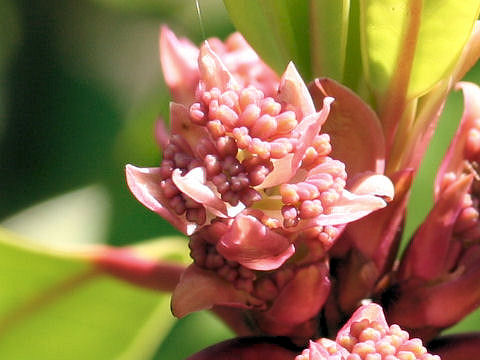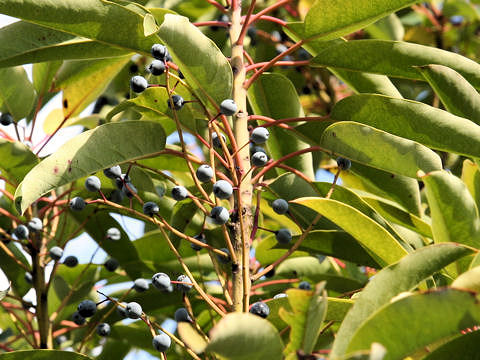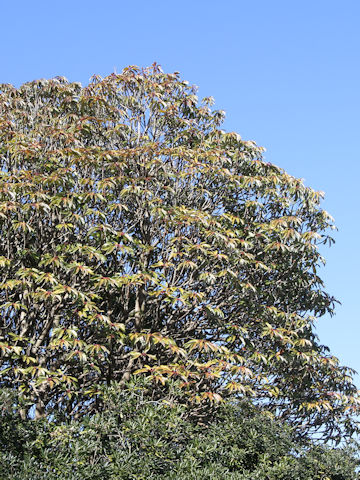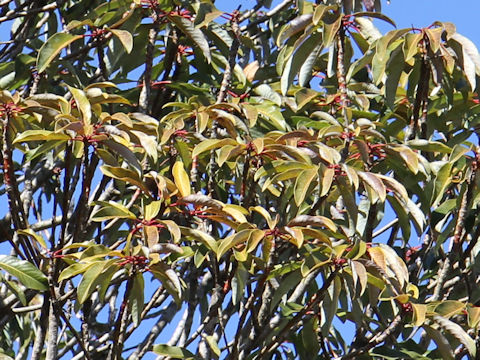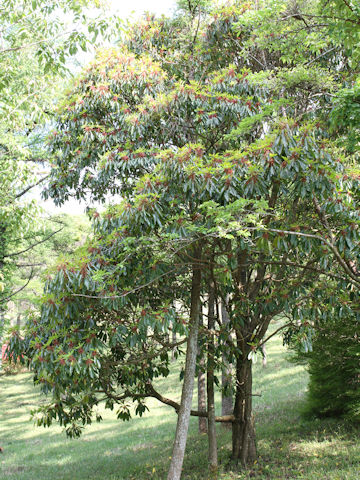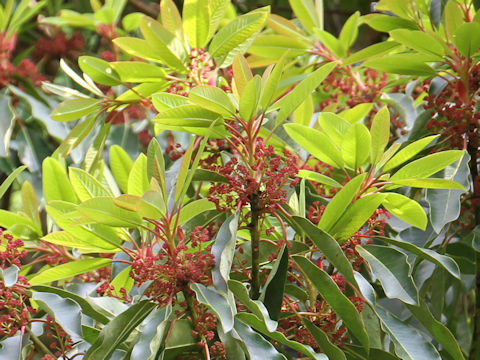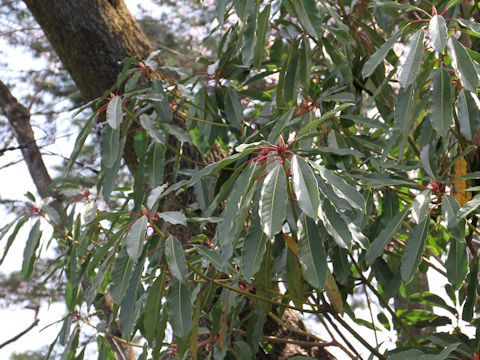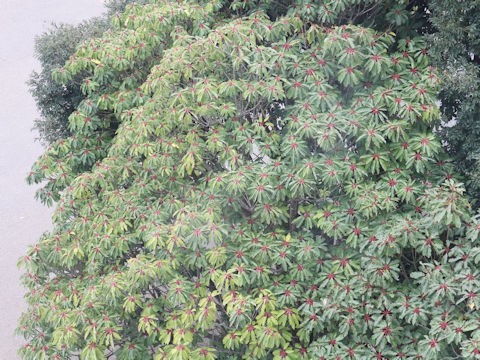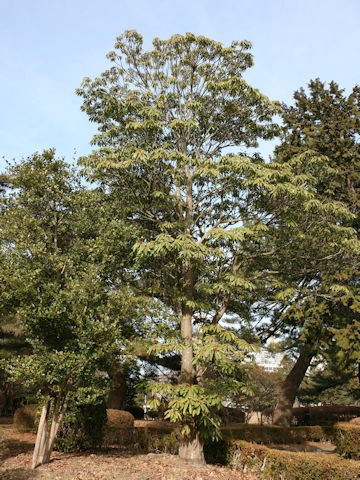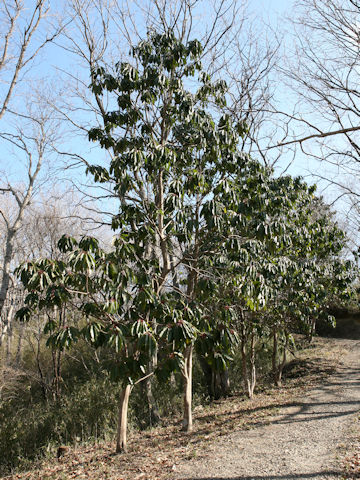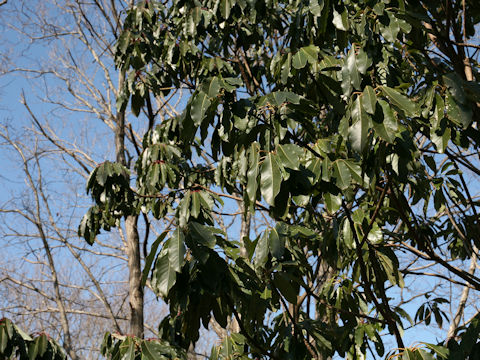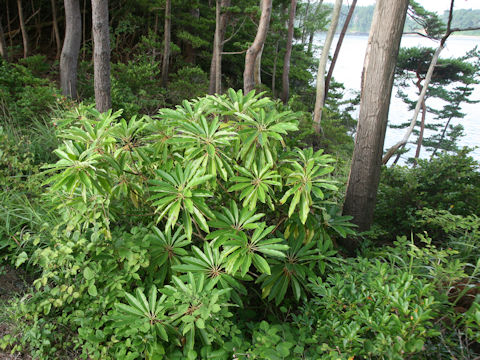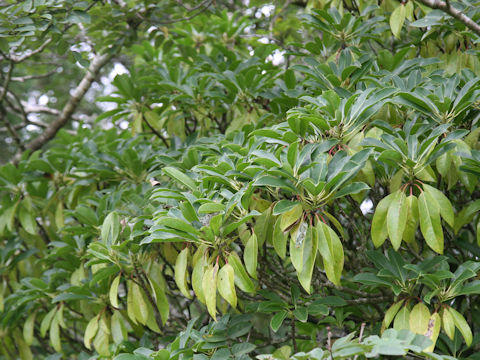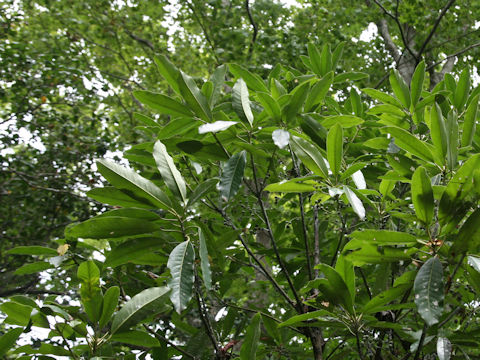
|
|
|
|
−− もっと見る(Show more)−−
−− 閉じる(Close) −−
|
|
|
|
わが国の本州、東北地方南部から四国・九州それに朝鮮半島南部や中国に分布しています。暖地の山地に生え、高さは10メートルほどになります。樹皮は灰褐色で縦に割れ目が入り、楕円形の皮目があります。葉は長楕円形から倒披針形で互生し、枝先に集まってつきます。5月から6月ごろ、前年枝の葉腋から総状花序をだし、花弁も萼片もない小さな花を咲かせます。果実は核果で、10月から11月ごろ藍黒色に熟します。和名は、若葉が伸びてから古い葉が落ちることから。これを親が成長した子どもに後を譲るのにたとえて、おめでたい木とされ、古くから正月飾りに使われています。中国語では「交譲木(jiao rang mu)」と呼ばれます。 |
|
|
ユズリハ科ユズリハ属の常緑高木で、学名は Daphniphyllum macropodum。英名は Yuzuri-ha。 |
|
|
The "Yuzuri-ha" (Daphniphyllum macropodum) belongs to the family Daphniphyllaceae. It is a tall evergreen tree that is distributed from southern Tohoku district of Honshu west to Shikoku, Kyushu in Japan, as well as the southern Korean Peninsula and China. This tree grows in the mountains of warm climate area and can reach about 10 m in height. The barks are grayish brown, longitudinally fissuered and have elliptical lenticels. The leaves oblong to obolanceolate, alternate and fascicled at terminal branches. The small apetalous and non-sepal flowers come on the axillary racemes in May to June. The fruits are drupes and ripen indigo black in October to November. The Japanese name comes from the fact that the old leaves fall off after the young leaves have grown. This is compared to parents passing on their successors to their grown children, and the tree is considered a tree of congratulations. It has been used for New Year's decorations since ancient times. In Chinese, it is called "交譲木" (jiao rang mu). |
|
|
[上・中1] 大阪市鶴見区「鶴見緑地公園」にて、2006年04月28日撮影。 [中5] 同上にて、2006年11月29日撮影。 [中2・中3] 大阪府交野市「大阪市大付属植物園」にて、2006年04月06日撮影。 [中4] 京都市左京区「京都府立植物園」にて、2006年03月29日撮影。 [中11] 同上にて、2007年01月15日撮影。 [中6] 福井県丸岡町「福井都市緑化植物園」にて、2002年11月09日撮影。 [中7] 愛知県名古屋市守山区「東谷山フルーツパーク」にて、2007年12月06日撮影。 [中8] 茨城県神栖市矢田部にて、2008年07月14日撮影。 [中9・中10] 東京都江戸川区「葛西臨海公園」にて、2008年08月03日撮影。 [中12・中13] 茨城県那珂市「茨城県植物園」にて、2015年02月01日撮影。 [中14・中15] 千葉県香取市大角にて、2016年05月23日撮影。 [中16〜中18] 宮城県大衡村「昭和万葉の森」にて、2017年03月30日撮影。 [中19・中20] 山形県山辺町「山形県県民の森」にて、2017年07月09日撮影。 [中21・中22] 愛知県名古屋市港区「ブルーボネット」にて、2017年08月03日撮影。 [中23〜中26] 大分県別府市「東山いこいの森」にて、2018年04月27日撮影。 [中27・中28] 宮城県仙台市宮城野区「榴岡公園」にて、2019年04月14日撮影。 [中35〜中37] 同上にて、2021年02月12日撮影。 [中29〜中31] 茨城県ひたちなか市「ひたち海浜公園」にて、2019年12月25日撮影。 [中32〜中34] 宮城県川崎町「みちのく湖畔公園」にて、2020年01月11日撮影。 [中38〜中40] 宮城県仙台市泉区「宮城県県民の森」にて、2021年03月09日撮影。 [中41・中42] 宮城県気仙沼市「気仙沼大島」にて、2024年08月04日撮影。 [中43〜中45] 宮城県村田町「浮島の植物群落」にて、2024年08月22日撮影。 [中46〜47・下] 宮城県松島町「福浦島」にて、2024年08月27日撮影。 |

|
|
Shu Suehiro |


